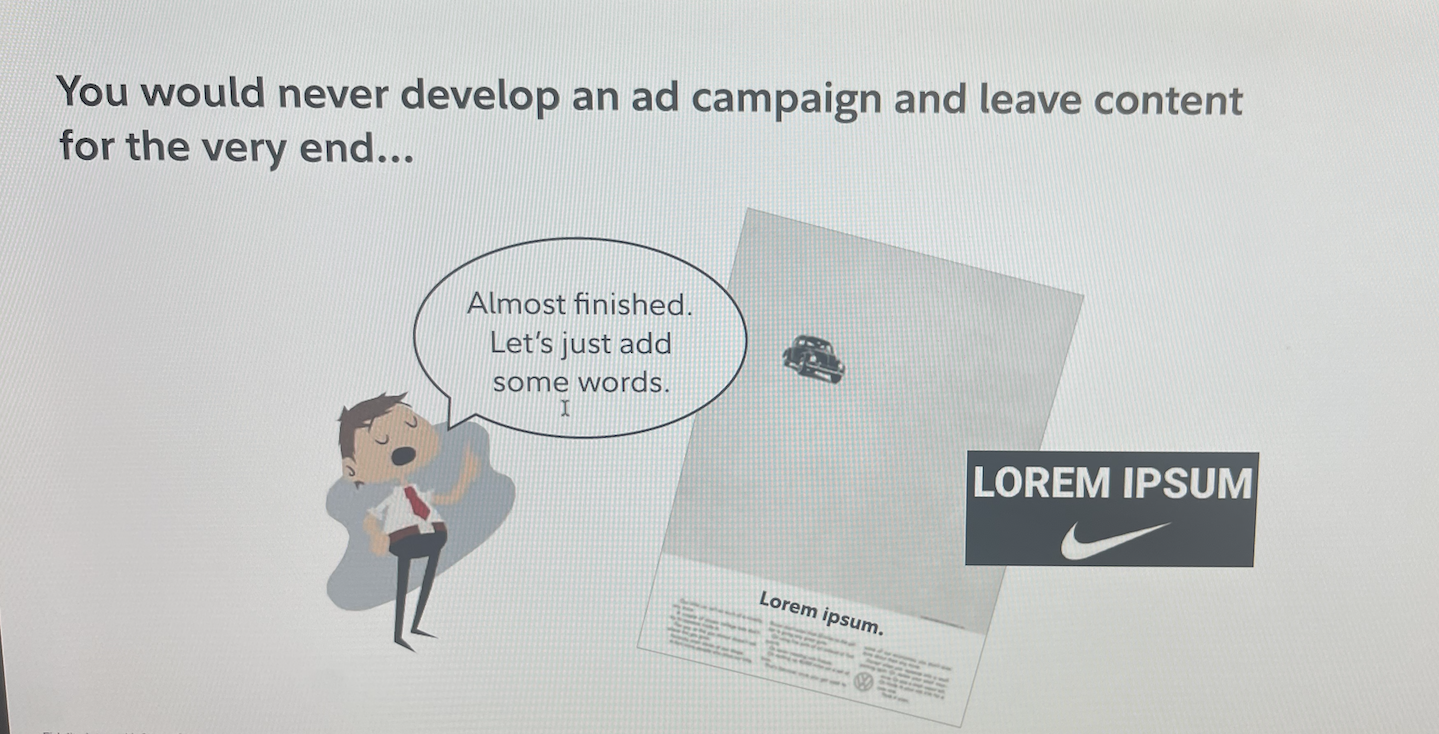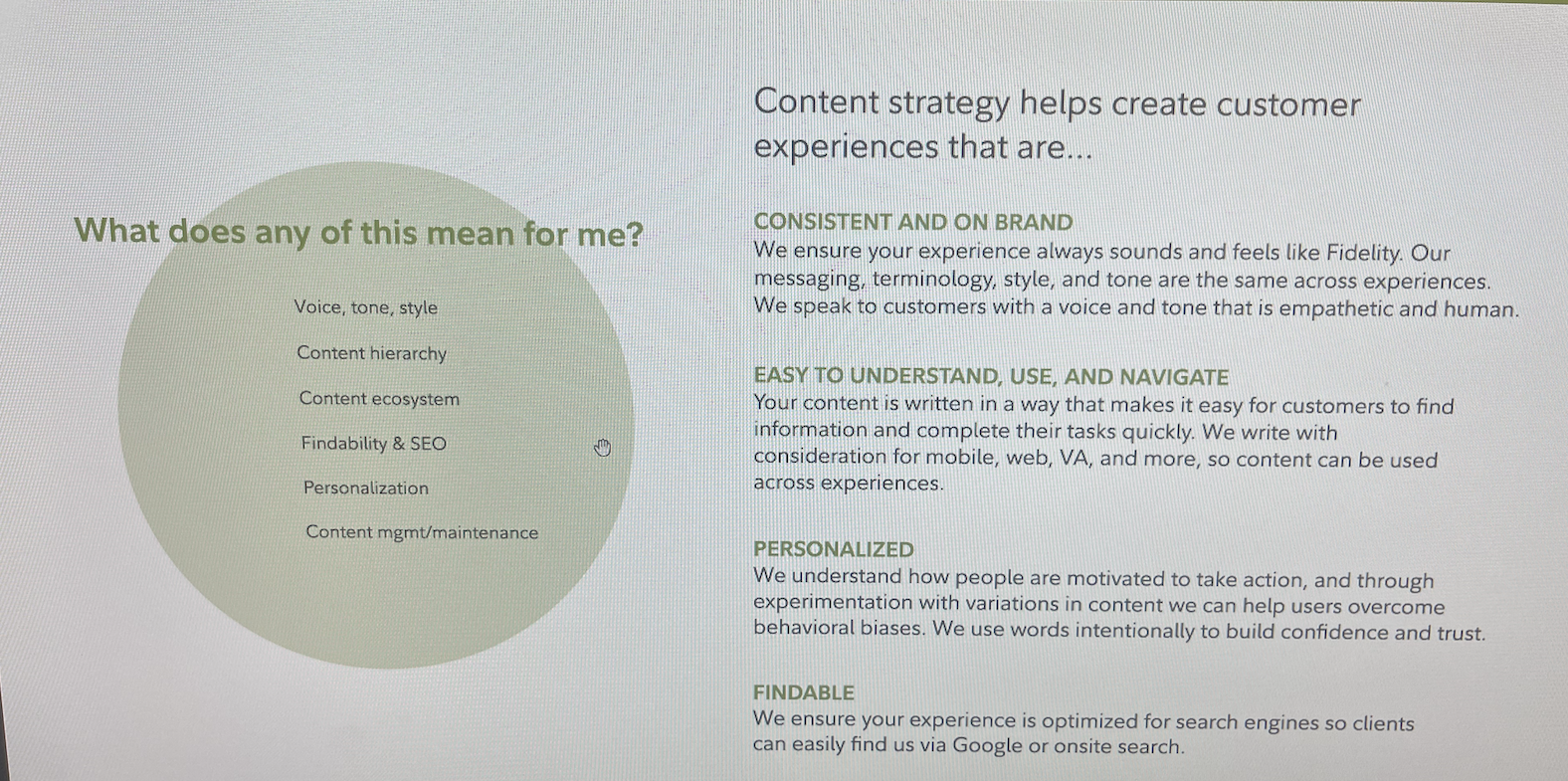Digital transformation
2017-2019+
Fidelity needed to stay competitive in an ever changing market where start-up fintechs were gaining ground and market share. Fidelity leadership knew that we needed to move to an agile way of working in order to have a future. Our customers were older and the younger generation wasn’t considering us when choosing financial institutions. We were their parents’ stuffy company who didn’t understand their needs. We needed to change or become irrelevant.
My contribution
Co-led the content team reorganization. Led creation of processes for content to work across multiple agile teams, piloted processes with one of my tribes, and oversaw the roll-out out across other tribes.
Led creation of websites and roadshows to help the organization understand content strategy and how to work with us.
Initial challenges
Content strategy was outside of the agile model
We weren’t trained or onboarded to agile methodologies like squads and chapters.
We were not staffed appropriately.
We missed the opportunity to build relationships and understand the goals of the tribes because we didn’t have a seat at the table.
We were not included in quarterly planning so we weren’t aware of the tribes’ priorities, but were expected to contribute to work that we had no insight into or input on (fill in this design with content).
Job roles and responsibilities were unclear
Squad leaders and squad members were placed in brand new roles, often in new businesses, and there was little training on job responsibilities. This resulted in many people thinking content was part of their job.
Some people were put in roles they didn’t want and weren’t necessarily skilled in.
Because everyone thought they were content creators, there were inconsistencies in style, tone, and terminology across products and channels.
Tribe goals and processes were undefined
Initially tribes and squads had no clear goals or KPIs but were expected to be making progress on ill-defined work.
As a content tribe, we weren’t sharing a consistent story about who we were and what we offered.
There were no clear processes around content engagement or legal, risk, and compliance (LRC) review.
How we overcame
Developed chapter-like processes
We trained the content team on Jira and created Kanban boards so we could have some insight into the work the teams were doing
We identified a process for prioritization so that the content team wasn’t working on everything we were asked to. We learned to say “no.”
I got Tribe Leader support for a process where the content team didn’t do work that wasn’t tied to an initiative. All content jobs had stories that were tagged with content and we pointed the stories so we knew how much an individual could get done in a single sprint. If the points exceeded the threshold, we’d work with the Tribe and Squad leads to either re-point or reprioritize the work.
Once we had a good process down, we invited LRC to participate. They implemented a similar process of tracking work in a Kanban board. We set up bi-weekly meetings with squad members, LRC, agile coaches, scrum masters, content, UXD and whoever else needed to participate.
Got the content story documented
I led a team to create a website that outlined the content strategy and design functions of our team but also showcased how we used technology to drive effective creation, storage, and distribution of content.
I later led a team to create a roadshow deck for executives to explain what the content team did. I gained the support of my manager and the CMO to share this with tribe leads who still weren’t bought in to using content in the squads.
Became settled with our place in the organization
As tribes and squads moved from forming, to storming, to norming, we got content involved in the right meetings and activities.
Content leadership team worked hard to get the content team to understand firm priorities, content tribe priorities, and the priorities of the tribes/squads they supported.
We tied our team’s quarterly objectives to the objectives of the tribes and squads we supported as well as the content tribe objectives. This enabled us to get the content team understand what the content tribe was doing and gave them incentive to encourage use of our technologies with their squads.
Agile process for content
All jobs must come through a Jira story tagged with [tribename]_CS
All stories must be tied to an initiative
Content strategist assigns points to the story
Content strategist meets with any Squad leads who have assigned them stories to prioritize work across squads
If they can’t agree on prioritization, I get involved and work with Tribe lead to prioritize
Everyone attends a bi-weekly meeting to look at content and legal work across the tribe to ensure we’re getting highest priority work done
I could filter the stories by each tribe or individual to have a clear look into the work happening across my team. This allows me to pull any strategist who may have a light sprint into other priority work as needed or give them an opportunity to work on special projects.
Legal review process
We used Kanban boards to manage priorities for legal, risk, and compliance (LRC) reviews. Every 2 weeks, relevant squad members, agile coaches, scrum masters, content, and LRC team members met to prioritize work.
This minimized the number of legal meetings and provided transparency into what LRC was focused outside of our tribe.
This vastly improved relationships with the LRC reviewers as the squad members gained empathy for the amount of work LRC had to do across multiple tribes.
Flash forward to 2020-2021
We overcame a lot of hurdles, built a solid process, tried to eliminate burn-out by empowering the team to say no to lower priority work, but we still had a way to go in terms of leveling the playing field with UXD staffing. We were outnumbered and there were still tribes who weren’t using our services. So we went on the road… (Virtually, of course)

We first had to appeal to our CMO who didn't quite appreciate our standing relative to design.

We outlined how we worked with UXD and why the squad needed both disciplines.

This was one of the case studies. We used behavioral science techniques to write next best actions to encourage engagement with unengaged audiences.

We helped the tribes to understand the value they would gain if we were part of the process. We had multiple case studies for each value prop.
We also let our business partners help us tell the story
It’s easy for us to tell the firm how valuable we are but the real impact came when we had our business partners become our advocates. It created a buzz around why some tribes had more content than others and tribe leads started fighting to get more content on their tribes.



